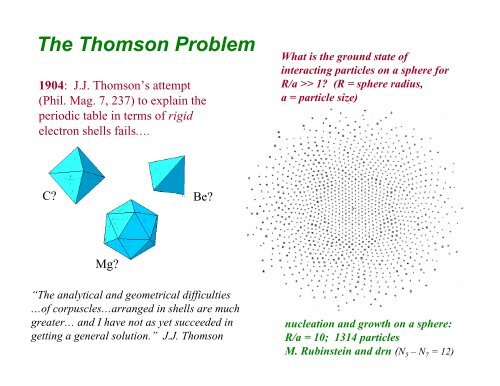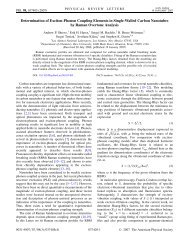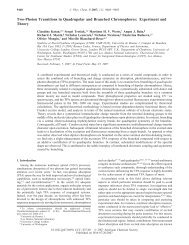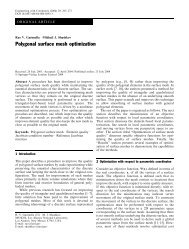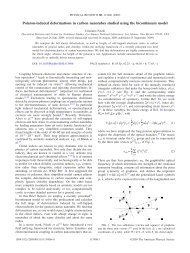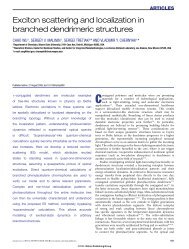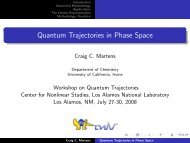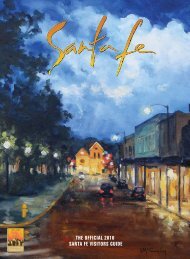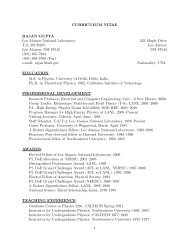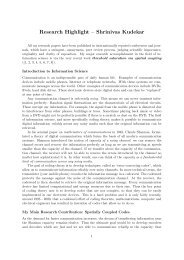The Thomson Problem
The Thomson Problem
The Thomson Problem
Create successful ePaper yourself
Turn your PDF publications into a flip-book with our unique Google optimized e-Paper software.
<strong>The</strong> <strong>Thomson</strong> <strong>Problem</strong><br />
1904: J.J. <strong>Thomson</strong>’s attempt<br />
(Phil. Mag. 7, 237) to explain the<br />
periodic table in terms of rigid<br />
electron shells fails….<br />
C?<br />
Mg?<br />
Be?<br />
“<strong>The</strong> analytical and geometrical difficulties<br />
…of corpuscles…arranged in shells are much<br />
greater… and I have not as yet succeeded in<br />
getting a general solution.” J.J. <strong>Thomson</strong><br />
What is the ground state of<br />
interacting particles on a sphere for<br />
R/a >> 1? (R = sphere radius,<br />
a = particle size)<br />
nucleation and growth on a sphere:<br />
R/a = 10; 1314 particles<br />
M. Rubinstein and drn (N 5 –N 7 = 12)
Spherical Crystallography: Virus Buckling<br />
and Grain Boundary Scars<br />
Particle packings on curved surfaces – “geometrical frustration”<br />
--<strong>Thomson</strong> problem: ‘theory’ of the periodic table (circa 1904)<br />
--Icosahedral packings in virus shells (N5 –N7 = 12)<br />
--<strong>The</strong>ory of disclination buckling in viruses<br />
--<strong>The</strong>ory of crumpling at high “Foppl-von Karman number<br />
Grain boundary scars and colloids on water droplets<br />
--What happens when shells cannot buckle? grain boundaries!!<br />
--Experiments: ‘colloidosomes’ on water droplets (A. Bausch et al.)<br />
--Grain bounaries in ground state terminate inside curved media….<br />
Liquid crystal textures on curved surfaces<br />
--Colloids with a valence<br />
--Baseball textures: ‘sp 3 hybridization’ on a micron scale….<br />
--Ordered states on bumps and torii<br />
M. Rubinstein<br />
S. Sachdev<br />
S. Seung<br />
L. Peliti<br />
J. Lidmar<br />
L. Mirny<br />
M. Bowick<br />
A. Travesset<br />
V. Vitelli
20 th century solutions of the <strong>Thomson</strong> problem….<br />
Fullerene molecule; (1,1)<br />
Geodesic house<br />
Geodesic Dome
Biological solutions of the <strong>Thomson</strong> problem …..<br />
Simian virus SV40<br />
(P, Q) = (1,2)<br />
•Flat surface: Triangular lattice tiles the plane<br />
•Ordering on a sphere: ‘geometric frustration’<br />
forces at least twelve 5-fold disclinations into<br />
the ground state…<br />
-Icosadeltahedral solutions of the <strong>Thomson</strong> problem for<br />
intermediate particle numbers are exhibited by the capsid<br />
shells of virus structures for ‘magic numbers’ of protein<br />
subunits indexed by pairs of integers (P,Q)<br />
D. Caspar & A. Klug,<br />
Cold Spring Harbor Symp.<br />
on Quant. Biology 27, 1 (1962)<br />
N = particle number = P + Q + PQ +<br />
2 2<br />
10( ) 2<br />
( PQ , ) = (1,0)<br />
( PQ , ) = (3,1)
A gallery of viruses…<br />
T.S. Baker et al., Microbiol. Mol. Biol. Rev. 63, 862 (1999)<br />
� <strong>The</strong> small viruses are round and large ones are facetted…
(P,Q) = (14,14)<br />
N = 5882<br />
(P,Q) = (6,6)<br />
N = 1082<br />
Strain<br />
energy<br />
Strain relaxation via disclination<br />
buckling in large viruses…<br />
M. Bowick, A. Cacciuto, A. Travessett and drn,<br />
Phys. Rev. Lett. 89, 185502 (2002)<br />
von Karman equations<br />
⎛u(x,x) 1 1 2 ⎞<br />
⎜ ⎟<br />
r(x ,x ) = r +<br />
⎜<br />
u (x ,x )<br />
⎟<br />
1 2 0 2 1 2<br />
⎜f(x 1,x 2)<br />
⎟<br />
⎝ ⎠<br />
2 2 2 2 2 2<br />
4 ∂ χ ∂ f ∂ χ ∂ f ∂ χ ∂ f<br />
κ∇<br />
f = + −2<br />
2 2 2 2<br />
� �<br />
∂y ∂x ∂x ∂y ∂x∂y ∂x∂yσij () r = εimε jn∂∂ m nχ()<br />
r<br />
2 2 2<br />
2<br />
� �<br />
1 4 ∂ f ∂ f ⎛ ∂ f ⎞ �<br />
= 2 µ uij ( r) + λδijukk(<br />
r)<br />
∇ χ =− +⎜ Sr ()<br />
2 2 ⎟ +<br />
4 µ ( µ + λ)<br />
Y ∂x ∂y ⎝∂x∂y⎠ Y =<br />
2µ<br />
+ λ<br />
Solve for ground state via a ‘tethered surface’<br />
floating mesh triangulation …..<br />
S. Seung and drn, Phys.Rev. A38, 1055 (1988)
E/Y<br />
Y / κ = 20<br />
Y / κ = 10<br />
Y / κ = 2<br />
Y / κ = 1<br />
flat( Y / κ → 0)<br />
Disclination buckling transition<br />
To solve von Karman equations<br />
must, in an Eulerian representation,<br />
minimze the nonlinear elastic energy:<br />
where,<br />
1 ⎡<br />
� �<br />
u ( ) ( )<br />
i x ∂ujx<br />
� �<br />
�<br />
∂ ∂f( x) ∂f(<br />
x)<br />
⎤<br />
uij ( x)<br />
= ⎢ + + ⎥<br />
2 ⎢⎣ ∂xj ∂xi ∂xi ∂xj<br />
⎥⎦<br />
2R<br />
E ~ Y R 2 , R < R b<br />
1 2 2 � 2 2 � 2 �<br />
E = d x[ κ ( ∇ f( x)) + 2 µ uij ( x) + λukk(<br />
x)]<br />
2 ∫<br />
� �<br />
n in<br />
α β<br />
E ~ κ ln (R/R b ), R> R b<br />
In a Lagrangian representation,<br />
minimize instead…<br />
ε<br />
� � � �<br />
∑ ∑<br />
2<br />
E = (| ri −rj | −a) −κnαinβ<br />
2 < ij><br />
< αβ , ><br />
Y<br />
2 3<br />
= ε<br />
3<br />
Disclinations buckle above<br />
a critical radius R b such that<br />
YR b 2 /κ = 154….<br />
But what about 12 interacting<br />
disclinations on a sphere?
Solution of the Foppl-von Karman<br />
equations for viruses (arbitrary vK!)<br />
�Shape depends only on the<br />
‘von-Karman number’ vK = YR 2 /κ<br />
κ = bending rigidity of shell<br />
Y = Young’s modulus of shell<br />
R = mean virus radius<br />
�(vK) c = 154 in flat space….<br />
Asphericity<br />
vK = YR 2 /κ<br />
J. Lidmar, L. Mirny and drn, Phys. Rev. E68,<br />
051910 (2003)
RMS deviation<br />
Fits to specific viruses<br />
2<br />
vK =<br />
YR / κ<br />
Yeast virus L-A<br />
vK = 547<br />
vK<br />
For a uniform elastic shell of radius R and<br />
thickness h and 3d Poisson ratio ν3… 2 2<br />
vK = 12(1 −ν3)(<br />
R / h)<br />
RMS deviation<br />
HK97 virus<br />
vK = 1480<br />
<strong>The</strong> precursor, capsid, or “prohead”, of<br />
HK97 is more spherical, in constrast to the<br />
larger, more facted mature form shown here.<br />
Evidence for a buckling transition ….
Large vK: Computer Simulations of Crumpling<br />
G. A. Vliegennthart and G. Gompper, Nature Materials (in press)<br />
A flat self-avoiding disk is crushed<br />
inside a hollow sphere from initial radius<br />
R 0 to a final radius R f by application of<br />
an inward radial force F….<br />
How does the energy of the creases depend on size?<br />
What is the effect of self-avoidance?<br />
Crushed triangular<br />
lattice, N = 61816<br />
particles…
Two interacting disclinations with separation L<br />
[A. Lobkovsky and T. Witten, see Physica A313, 83 (2002)]<br />
R<br />
2<br />
⎛1 1 ⎞<br />
2 2<br />
∫ ⎜ ⎟ ( ) ; 2 1 ~ , ~( / ) ,<br />
r1 r ∫ ∫<br />
2<br />
R<br />
r 1<br />
ridge radius of<br />
curvature r1~ y,<br />
y = downward<br />
deflection<br />
Etot ≈ κ da + + Y da ε r >> r y ε y R da= yR<br />
⎝ ⎠<br />
~ 0<br />
5<br />
1/6 1/6<br />
R y * ⎛κ⎞ 2/3 * ⎛Y ⎞ 1/3<br />
tot ( ) ≈ + → ≈ , ( )<br />
3<br />
tot ≈<br />
E y κ Y y ⎜ ⎟ R E y κ⎜ ⎟ R<br />
y R ⎝Y ⎠ ⎝κ⎠ y R vK E y vK vK YR<br />
1/6 1/6 2<br />
~ /( ) , tot ( )~ κ( ) , = / κ �1<br />
YR 2 /κ = vK = Foppl-von<br />
Karman number is a kind<br />
of “Reynolds number”<br />
for crumpling…
Osmotic Crushing of Amorphous Shells<br />
Experiments by Andreas Bausch, Tech. Univ. of Munich<br />
�Amorphous colloidal assemblies formed on<br />
water droplets in oil. <strong>The</strong> exterior oil is replaced<br />
by water and the resulting shell crushed<br />
osmotically (bottom) to produce a crumpled<br />
object with vK = 10 7<br />
�In the presence of thermal fluctuations, the<br />
bending rigidity and Young’s modulus become<br />
strongly dependent on length scales<br />
η<br />
−ηu<br />
κ () l ≈κ(/ l l ), Y () l ≈Y(/<br />
l l )<br />
R th R th<br />
η ≈0.75 −0.80 ηu ≈ 0.36 − 0.50<br />
l = k TY l ≈ 40nm<br />
3 2<br />
th 4 πκ /( B )<br />
r R R<br />
(4 + ηu)/(6 −η)<br />
0.76<br />
~ ~ ,<br />
u u<br />
E ~ R<br />
~R<br />
(2+ 3 η− η + ηη )/(6 −η)<br />
0.74<br />
2/3 1/3<br />
(without thermal fluctuations, r ∼ R , E ∼<br />
R )<br />
th<br />
R<br />
r<br />
7<br />
vK ≈10<br />
r<br />
L
Spherical crystallography of ‘colloidosomes’<br />
(see also “Pickering emulsions”)<br />
“Colloidosome” = colloids of<br />
radius a coating water droplet<br />
(radius R) -- Weitz Laboratory<br />
Ordering on a sphere � a minimum of 12<br />
5-fold disclinations, as in soccer balls and<br />
fullerenes -- what happens for R/a >> 1 ?<br />
� Adsorb, say, latex spheres onto lipid bilayer vesicles or water droplets<br />
� Useful for encapsulation of flavors and fragrances, drug delivery<br />
[H. Aranda-Espinoza e.t al. Science 285, 394 (1999)]<br />
�Strength of colloidal ‘armor plating’ influenced by defects in shell….<br />
� For water droplets, surface tension prevents buckling….<br />
Confocal image: P. Lipowsky, & A. Bausch
�If droplet surface tension<br />
enforces spherical shape,<br />
disclination buckling is replaced by<br />
an instability towards grain boundaries….<br />
�can insert the required dislocations into<br />
the ground state by hand….<br />
�or construct a continuum elastic theory of<br />
topological defects on the sphere…:<br />
Grain boundary instabilities<br />
M. J. W. Dodgson and M. A. Moore, Phys. Rev. B55, 3816 (1997)<br />
Perez-Garrido, M.J.W. Dodgson and M. A. Moore, Phys. Rev.B56,<br />
3640 (1997).<br />
Alar Toomre (unpublished)<br />
A. Perez-Garrido and M. A. Moore, Phys.Rev. B60, 15628 (1998)<br />
M. J. Bowick, A. Travesset and drn, Phys. Rev. B62, 8738 (2000)
Continuum elastic theory of defects on<br />
spheres<br />
� Finding the ground state of ~26,000 particles<br />
on a sphere is replaced by minimizing the energy of<br />
only ~ 250 interacting disclinations, representing<br />
points of local 5- and 7-fold symmetry.<br />
Dislocation = 5-7 pair =<br />
Grain boundary = 5-7 5-7 5-7 …<br />
= …<br />
π Y<br />
E R qq NE<br />
N N<br />
2<br />
i i j j<br />
(Y) = ∑∑ i j χθ ( , φ; θ , φ)<br />
+ core<br />
36 i= 1 j= 1<br />
(1−cos β )/2<br />
a a b b 2<br />
ln z<br />
= R + ∫ dz<br />
0<br />
⎛ ⎞<br />
χθ ( , φ; θ , φ)<br />
⎜1 ⎟<br />
⎝ 1−<br />
z ⎠<br />
[χ Solves biharmonic eq. on a sphere]
Continuum elastic theory of defects on<br />
spheres<br />
� Finding the ground state of ~26,000 particles<br />
on a sphere is replaced by minimizing the energy of<br />
only ~ 250 interacting disclinations, representing<br />
points of local 5- and 7-fold symmetry.<br />
Dislocation = 5-7 pair =<br />
Grain boundary = 5-7 5-7 5-7 …<br />
= …<br />
π Y<br />
E R qq NE<br />
N N<br />
2<br />
i i j j<br />
(Y) = ∑∑ i j χθ ( , φ; θ , φ)<br />
+ core<br />
36 i= 1 j= 1<br />
(1−cos β )/2<br />
a a b b 2<br />
ln z<br />
= R + ∫ dz<br />
0<br />
⎛ ⎞<br />
χθ ( , φ; θ , φ)<br />
⎜1 ⎟<br />
⎝ 1−<br />
z ⎠<br />
[χ Solves biharmonic eq. on a sphere]<br />
What happens for<br />
real colloidosomes?<br />
(silanized silica beads)
R/a >> 1: Grain Boundaries in the Ground State!!<br />
Defect Screening as a Function of R/a (75% a cut)<br />
Associated Dislocations per Unpaired Disclination<br />
10<br />
8<br />
6<br />
4<br />
2<br />
0<br />
0 5 10 15 20 25<br />
R/a<br />
Bausch et al. Science 299, 1716 (2003)<br />
polystrene beads on water….<br />
(R/a) c ≈ 5, determined by<br />
dislocation core energy
R/a >> 1: Grain Boundaries in the Ground State!!<br />
Defect Screening as a Function of R/a (75% a cut)<br />
Associated Dislocations per Unpaired Disclination<br />
10<br />
8<br />
6<br />
4<br />
2<br />
0<br />
0 5 10 15 20 25<br />
R/a<br />
Bausch et al. Science 299, 1716 (2003)<br />
polystrene beads on water….<br />
Slope<br />
3<br />
π −<br />
= ⎡ − ⎤<br />
⎣ ⎦<br />
≈<br />
1<br />
11 5cos (5/ 6) 0.41<br />
(R/a) c ≈ 5, determined by<br />
dislocation core energy
Vacancies and interstitials on curved surfaces<br />
interstitial movie, courtesy of Mark Bowick, Cris Cecka and Alan<br />
Middleton; see also, http://www.phy.syr.edu/condensedmatter/thomson/<br />
V = vacancies<br />
I = interstitials
1904: J. J. <strong>Thomson</strong> asks how particles pack<br />
on a sphere – relevant to viruses, colloid-coated<br />
droplets, and multielectron bubbles in helium<br />
Simian virus SV40<br />
<strong>The</strong> <strong>Thomson</strong> <strong>Problem</strong> and Spherical Crystallography<br />
“Colloidosome” = colloids of<br />
radius a coating water droplet<br />
(radius R) -- Weitz Laboratory<br />
Ordering on a sphere � a minimum of 12<br />
5-fold disclinations, as in soccer balls and<br />
fullerenes -- what happens for R/a >> 1 ?<br />
�Continuum elastic theory (with M. Bowick and A.<br />
Travesset) shows that the 5-fold disclinations<br />
become unstable to unusual finite length grain<br />
boundaries (strings of dislocations) for R/a >> 1.<br />
� Finding the ground state of ~26,000 particles<br />
on a sphere is replaced by minimizing the energy of<br />
only ~ 250 interacting disclinations, representing<br />
points of local 5- and 7-fold symmetry.<br />
� Grain boundaries in ground state for R/a > 5-10<br />
have important implications for the mechanical<br />
stability and porosity of colloidosomes, proposed as<br />
delivery vehicles for drugs, flavors and fragrances.<br />
Dislocations (5-7 defect pairs) embedded in<br />
spherical ground states
Nematic textures on spheres: toward a tetravalent<br />
chemistry of colloids… [drn, NanoLetters, 2, 1125 (2002)]<br />
North<br />
Pole<br />
+1<br />
Z = 2 Z = 4<br />
( ) total = 2π<br />
K ln R a c<br />
( )<br />
E +<br />
+½ +½<br />
Etotal = π Kln R a + c'<br />
Long-range repulsion ⇒<br />
TETRAHEDRAL DEFECT ARRAY
Linking colloids with a valence<br />
Possible nematogens include gemini lipids,<br />
(say, on an oil droplet), triblock<br />
copolymers, and CdSe nanocrystals.<br />
• <strong>The</strong> four unique “bald spots” on a nematiccoated<br />
sphere can be functionalized with<br />
DNA linkers…<br />
• may be possible to reproduce the quantum<br />
chemistry of sp 3 hybridization on the micron<br />
scale of colloids….<br />
functionalize<br />
colloidal particles<br />
with , e.g., DNA…<br />
Fluoresent beads on nematic droplet<br />
colloidal analogue of sulfer…<br />
Z. Cheng, D. Link and P. Lu, Weitz group
Experiments: Alberto Fernandez-Nieves, Weitz Laboratory<br />
Outer liquid Fluid<br />
Making nematic shells: double emulsions<br />
Inner liquid Fluid<br />
Middle Middle liquid Fluid<br />
Collection tube Tube<br />
Injection Tube<br />
Injection tube<br />
Anchoring at inner and outer surface: PLANAR<br />
Viscosities: η outer > η inner , η middle<br />
Outer liquid: Glycerol + water + PVA<br />
Middle liquid: Chloroform + LC (5CB)<br />
Inner liquid: Water + PVA<br />
Water droplet coated<br />
with a nematic shell of<br />
thickness h<br />
h<br />
LC+chloroform shell
Z =4<br />
110 micron<br />
droplet;<br />
shell ~ 6-8<br />
microns<br />
Z = 2<br />
100 micron<br />
droplet;<br />
shell ~ 6-8<br />
microns<br />
Z = 3<br />
90 micron<br />
droplet;<br />
shell ~ 4-7<br />
microns<br />
In fact, valences Z = 4, 3 and 2 are possible….<br />
4 defect shell<br />
(Inhomogeneous shell<br />
thickness distorts<br />
perfect tetrahedron…)<br />
2 defect shell<br />
3 defect shell!!<br />
(See M. Kleman and<br />
O. D. Lavrentovich)
disclinations (thin films) vs. ½ - hedgehogs (thick films)<br />
Assume a homogeneous thickness h and a single Frank constant K…..<br />
Z = 4 shell<br />
(four s = ½ disclinations)<br />
Z = 2 shell<br />
(two pairs of ½-hedgehogs…)<br />
R<br />
E4= 4 × ( π K/ 4) Khln( R/ a)<br />
+ ... E2= 2 × ( π K) hln( R/ h)<br />
+ ...<br />
• ½-hedgehog defects preferred for h > hc ,<br />
such that E4 (h) > E2 (h)<br />
• this leads to h = const. × Ra<br />
c<br />
a = core radius<br />
h<br />
a<br />
h<br />
Z = 2<br />
Z = 4<br />
R/ a<br />
Z = 3?
Nematic order parameter<br />
Colloids with nematic<br />
shells of thickness h….<br />
Which surface texture dominates?<br />
OR ?<br />
*Colloids with Z = 4 are always<br />
energetically preferable for<br />
thin nematic coatings<br />
*But colloids with Z = 2 appear above a<br />
thickness h* ≈ const.√(R a); R = sphere<br />
Radius a = microscopic length<br />
h<br />
a<br />
Z = 2<br />
Z = 4<br />
R/ a
Curvature-induced defect unbinding on the torus<br />
�Consider hexatic order on a torroidal template<br />
� no topological necessity for defects in the ground state<br />
� nevertheless, Gaussian curvature causes a defect-<br />
M<br />
unbinding transition for M < M c , for “fat” torii and<br />
moderate vesicle sizes….<br />
2<br />
8 π R 1 R 2<br />
= = 2 number of microscopic<br />
3 a 0 degrees of freedom<br />
⎛r+ 1⎞<br />
M c ≈ 4.6 r⎜ ⎟ , r = R1/ R2,<br />
⎝r−1⎠ [M. Bowick, A. Travessett and drn, Phys. Rev.E(in press)]<br />
12<br />
M. Mutz and D. Bensimon,<br />
Phys. Rev. A43, 4525 (1991)<br />
Mc= r =<br />
Clifford torus<br />
10<br />
10 , 2,
Defect generation and deconfinement on corrugated<br />
topographies<br />
Equilibrium hexatic phases formed by templating<br />
large ordered arrays of block copolymer spherical<br />
domains on silicon substrates (Segalman et al.<br />
Macromolecules, 36, 3272, 2002)<br />
A Gaussian bump<br />
(prepare lithographically)<br />
(Vincenzo Vitelli and drn)<br />
Dislocations can be generated<br />
thermally OR by increasing the<br />
curvature of the substrate ….<br />
Smooth ground state texture for an XY model<br />
on the bump.<br />
Experiments by Rachel<br />
Segalman, Alex Hexamer<br />
and Ed Kramer, UCSB


